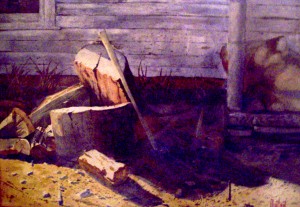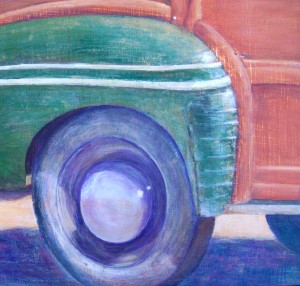
The contrast of dark values against light ones creates the illusion of three-dimensionality. This is needed to portray believable forms.
Often, nature will present the artist with conflicting light sources that can destroy the illusion of form. Random spots of light and shade can break up shapes and make them difficult to perceive. When this occurs, use the artistic license giving to all of us with pen, pencil, or brush in hand and choose only one distinct light source.
When artist work in nature’s natural light rather than controlled light they often make changes in the hues and values in an effort to portray their painting more convincing and understandable to the viewer.
The painting above presented these problems to me when and I painted it and I had to take artistic license to make it believable. Although the waning sun had not yet set and there was plenty of light shining at an angle on the left side of the painting, for some reason a bright light was shining on the porch from the right side and affected the shadows and did not make them appear realistic. In other words there was a controlled light source coming where it would be hard to explain unless I chose to paint the source of the controlled light, which I elected not to because of the composition.

The shadows that appear on and around a form is important to the rendering and portraying of that form. In the detail to the right of the hubcap and tire is an example of what I mean. Shadows identify what type of form you are looking at.
The shadow angled to the left and below the hubcap as it works its way in and out of the inset wheel rim lets you know their is natural sunlight shining down at around one o’clock in the afternoon. It also lets you know the hubcap sticks out.
